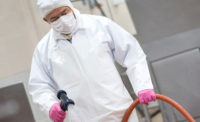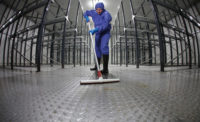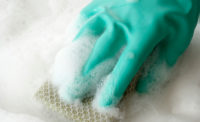Keeping sanitary workers safe in meat and poultry plants can be tough.
Cleaning crews face threats ranging from handling toxic chemicals to potentially hazardous encounters with meat processing equipment.
Yet, while extensive worker training will help minimize incidents, many plant operators are unable or unwilling to invest in the necessary amount of training or are unclear about safety requirements, analysts say.
“The cleaning equipment itself is relatively safe,” says Norman Marriott, emeritus professor in the College of Agriculture and Life Sciences at Virginia Polytechnic Institute and State University (Virginia Tech) in Blacksburg. “There shouldn’t be injuries if workers handle machinery properly. But incidents often result from employee carelessness or workers not receiving proper training.”
Many injuries, for instance, are from contact with the meat processing machinery that is undergoing cleaning, rather than from the sanitizing gear, he says. Workers can suffer severe cuts when dealing with sharp blades and other moving parts of mixes and grinders, he says.
While it is safest to clean equipment while it’s powered down, some workers keep machines in motion during sanitizing as it can be difficult or impossible to reach some areas within the apparatus unless the parts are moving, Marriott says.
Workers also risk serious or fatal injuries by having their hands or clothing caught on moving conveyors during cleanings, he says, and they often are susceptible to burns from the use of steam or boiling water during sanitizing.
Performing non-routine tasks and handling newer or extra strong chemicals also can lead to worker injuries, says Jen Allen, vice president of operations and engineering for Allen Safety, an Orlando-based global safety and process improvement company.
“More and more workers are using unique blends of chemicals in ways that the chemical manufacturers did not anticipate, such as in spaces with limited ventilation or having the chemicals atomized in a fogger,” Allen says. “Couple that with employees performing unfamiliar or infrequent tasks with no documented procedures to follow or for which they have no training and the door opens for mishaps to occur.”
The need for companies to quickly respond to food safety outbreaks or plant contamination only intensifies the risks, she says.
“Pressure to swiftly eliminate any contaminant is at an all-time high because of the prospect of a processing plant losing money from production downtime or a tanked product,” Allen says. “That can supersede a push by plant operators to create and train workers on a procedure, perform the necessary risk analysis or validate that the right personal protective equipment (PPE) is on hand for performing new functions, in new areas, with new chemicals or chemicals used in a new way.”
Employees also can face perils when mixing chemicals in preparation for sanitizing, says Larry Keener, president and chief executive officer of Seattle-based International Product Safety Consultants.
“The compounds are strong oxidizers in many instances, and therefore highly reactive,” he says. “When mishandled or not mixed properly, workers can cause the release of toxic gases in the work area.”
Third shift must be first class
Despite the importance of employees following correct measures when sanitizing facilities, plant operators often find their greatest challenge is developing optimal cleaning procedures and ensuring workers adhere to the guidelines, analysts say.
A major issue is seeing that third-shift employees are given the same guidance and attention as other workers, Keener says.
He says it can be difficult to ensure all third-shift personnel are up to speed with safety precautions because there is typically a high turnover rate within the sanitation crews. That often results from low wages, having to work overnight “and a culture that appears to be less than appreciative of the vital and hard work that the crews perform,” Keener says.
In addition, because of the frequent turnover, there is typically a need for third-shift replacements to begin work immediately, Marriott says. There are also fewer supervisors present during the third shift to monitor activity and some are not cognizant about who needs training, he says.
“Third-shift workers frequently operate by following what they already know or see” rather from new training, Marriott says.
Keep training top of mind
The most effective instruction typically begins with hands-on simulated activity, Allen says.
“What makes the training stick is when employees see that those protocols are continuously supported by their supervisors and managers — when they observe that management is not allowing those employees who are unable to follow proper measures to perform the work,” she says.
Allen says it is “extremely damaging to the safety culture” of a plant when supervisors overlook procedural miscues because of the cost of training and/or the expense of providing workers with proper equipment.
Companies that place a high value on worker safety and performance often have their own in-house manuals that cover sanitizing specific apparatus, along with computerized training systems, short courses and seminars, Marriott says.
Because English is not many workers’ first language and illiteracy may be an issue in some cases, getting all employees to comprehend effective sanitizing procedures can be difficult, he says.
“That is why on-the-job training and close supervision is important,” Marriott says. “Managers can observe workers and immediately correct those employees whose actions are dangerous or ineffective.”
Yet, Keener says there are opportunities to include other languages in computer training programs, which “has been a great improvement in the delivery of fundamental education about the safe use and application of chemicals.”
Other procedural enhancements include the move by some companies to require hands-on training for workers who use or mix chemicals, and vendors also frequently assist in instructing employees about the use, application and storage of hazardous sanitation chemicals, he says.
Some operators, meanwhile, contract out for sanitizing services from specialized companies, Marriott says, particularly when plant managers lack the necessary knowledge for overseeing cleaning activity.
Ignorance has consequences
While many safety guidelines intended to protect sanitation crews fall under the Occupational Safety and Health Act of 1970 (OSHA), not all companies meet them, says Jeffrey Lancaster, president and chief operating officer of Lancaster Safety Consulting, a Wexford, Pa.-based business management firm specializing in OSHA compliance.
The act sets minimum standards that employers must follow to reduce or eliminate workplace hazards. Under OSHA, employers are held responsible for training, implementing effective safety programs, maintaining equipment and continually assessing the workplace to remove or mitigate any hazards present.
Lancaster says that for the best results, operators should tailor training programs to the particular elements inherent to each of their plants, including the unique dangers. Measures can include having proper ventilation for acceptable air quality, adequate lighting “so workers can see what they are doing,” the necessary safety guards on equipment and the optimal personal protective equipment, he says.
“You don’t want generalization,” Lancaster says. “The more gaps that are in a safety program, the more likely that injuries can occur. Plans must be site-specific, task-specific and work-specific for their operation.”
Safety risks are increased by plant operators who are ignorant about necessary safety measures, including OSHA guidelines, he says.
“The unknown factor is that some plant operators don’t know their safety requirements,” Lancaster says. “They usually aren’t aware of the formalities that are necessary.”
In addition, many business owners “simply do not have enough time in the day, or dollars in the checkbook, to stop and shut down the work force and production to train their workers,” he says. “That’s the sad reality that is driven by production requirements.”
The most successful companies, he says, are proactive and view safety and worker training as an investment that generates a large return.
“Preventing injury saves so much money,” Lancaster says. “It drives the worker compensation costs down, prevents extensive OSHA fines and promotes a good camaraderie or culture among the workers where there is more retention and less turnover. A safer workplace usually results in a healthier bottom line.”
Stay in step with change
Even the best training cannot prevent all incidents from occurring. Cleaning hoses may rupture and boiling water may accidently spill on employees, Marriott says.
While personal protective equipment is intended to help protect workers in such instances, plant operators need to ensure they are continually upgrading the materials to withstand evolving threats, Allen says.
More sanitizers, for instance, are undergoing atomization for fogging purposes and there are new blends of chemicals, she says. While such items can reduce the need to hand scrub machinery and surfaces while treating areas that are difficult or often impossible to access, they may also require users to wear more effective protective equipment, Allen says.
While improvements to personal protection equipment have been steadily made over the last 10 years, further enhancements must keep pace with evolving threats, Keener says.
He says sanitizing devices are continually improved. Some, for example, allow for better flow and spray pattern control.
“These measures have the benefit of helping to reduce the inadvertent exposure of chemicals to the sanitation crews,” Keener says.
While many meat and poultry plant operators are aware of safety risks facing sanitizing crews and take the appropriate steps to create a more secure environment, some facilities remain subpar, Allen says.
“The biggest challenge is for workers and supervisors to create and maintain effective and productive communication with plant management so that time can be allotted for sanitation employees to perform risk analysis, order the proper personal protective equipment and create operating procedures or training methods when reacting to positive swabs, outbreaks and requests to clean new areas of the plants or to clean existing areas in new ways,” she says. NP





Report Abusive Comment